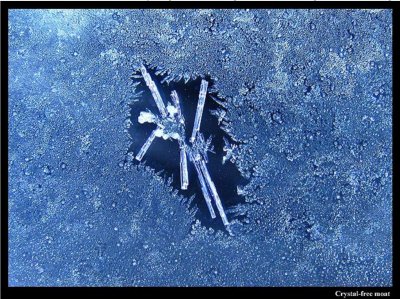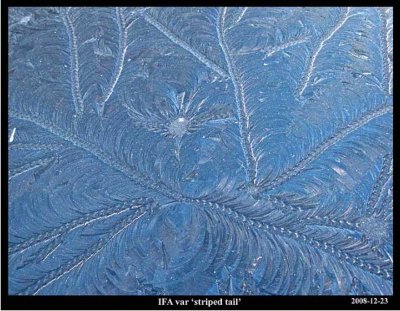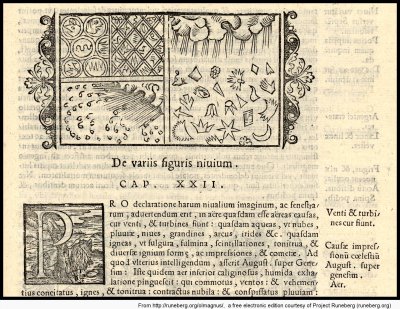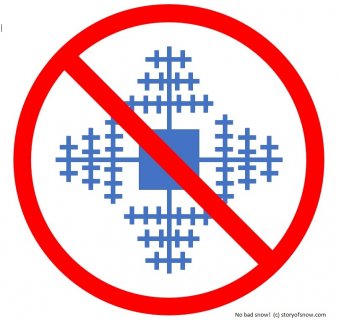Category: "History of snow and ice"
Bentley’s Most Singular Observation
March 2nd, 2022[This is the seventh and last in the series of re-posted articles, from 2012.]
You don’t have to look at frosted surfaces for very long before coming across something like the following.
The picture shows a large ice crystal amid a roughly uniform sea of tiny frozen droplets. Between the large crystal and the frozen droplets lies a clear ice-free zone, a dry moat around an island of ice. Sometime prior to 1907, the Vermont farmer Wilson A. Bentley took notice of this moat. Writing in the Monthly Weather Review in 1907, he wrote
"One of the most singular, and doubtless most important, phenomena that occur in connection with the formation of window frost is this: The true crystalline varieties of window frost ordinarily, apparently, repel the minute liquid particles or droplets of water that frequently collect like tiny dew-drops on the glass, and freeze in granular form thereon."
Ice Classification System of Bentley
February 24th, 2022[This is the fifth in the series of re-posted articles, from 2010.]
The most comprehensive study of frost and small ice formations was published way back in 1907 by Wilson A. Bentley. His article was split into five successive issues of the Monthly Weather Review (1) with the title “Studies of Frost and Ice Crystals”. In the article, Bentley details his classification system for frost and some related ice forms, and gives examples of nearly every type – in total 274 examples in photographs. His classification system is ingenious, the first (and probably only) classification system for frost and ice on surfaces. Unfortunately for such an extensive, pioneering article, few books or articles reference it.
Snow Crystal Variety and the Bentley Length Scale in Clouds
February 22nd, 2022[This is the fourth of the re-posted articles, from 2009.]
“… by means of these wonderfully delicate and exquisite figures, much may be learned of the history of each crystal and the changes through which it has passed in its journey through cloudland.”
W. A. Bentley, 1898
“… the crystals will in all probability be greatly modified by passing through atmospheric strata varying so greatly in density, temperature, humidity, etc. That they are greatly modified by these flights in the cloud is clearly shown by the interior structure of many of the crystals. ”
W. A. Bentley, 1901
Long ago, Wilson Bentley argued that the various layers (‘strata’) of air that a snow crystal falls through largely determine the appearance of the crystal. The first direct support of this claim came about 30 years later, from laboratory experiments by Ukichiro Nakaya, a Japanese physicist. Now, 100 years later, probably all cloud scientists would agree with Bentley. So, with all the crystal and cloud research that has been done since Bentley and Nakaya, can we determine the history of a crystal if we see its form? Can we finally do what Bentley said we should be able to do?
The Jericho Farmer and the Electric Crystals
February 22nd, 2022[This is the third of the re-posted articles, from 2008.]
For most of his life, and while not attending to farm duties, Wilson A. Bentley was captivated by the beauty of snow crystals. Perhaps then it should not be too surprising that he pondered the physical cause of their symmetry and intricacy. His thoughts turned to electricity as an explanation, perhaps influenced by his era's popular-culture infatuation with the new-fangled electrical devices. Though erring in the details, he was clearly onto something as I will show.
He considered that the crystalline surfaces had electric charges, with more charges concentrated at branch tips (1). When the tips of the branches overflowed with charge, the charges dribbled down the sides to produce ‘growth nuclei’ for the sidebranches. This process, he argued, could explain the symmetry of snow crystals:
"That the crystals, when permitted, attain to such a marvelous degree of symmetry and complicity, shows that the alignment of the growth nuclei, presumably tiny electric charges, is symmetrically regular to an almost unbelievable degree."
Here he connects electricity to the formation of sidebranches and the branch symmetry. In other writings, he connects snow electricity to growth rate, and snow electricity to lightning. In the specific details he was wrong, but in general he was surprisingly prescient. Snow crystals are indeed electric crystals, and the electricity itself is captivating. To see why, consider some of the amazing things that Mr Bentley’s electric crystals can do.
Musings on Bentley’s ‘no two alike’
February 22nd, 2022[This is the second of the re-posted articles, from 2007.]
Wilson Bentley is famous for his phrase ’no two alike’, but what did he really mean by it? Excerpts in Duncan Blanchard’s book suggest that Bentley was usually referring to only the crystals he photographed (1).
Sometimes though, Bentley seems to be referring to all snow crystals. Maybe sometimes he meant it one way and sometimes the other; however, I wonder if he also had a third, and more profound, meaning in mind, a meaning suggested in his passage (2):
The deeper one enters into the study of Nature, the
further one ventures into and along the by-paths that,
like a mystic maze, thread Nature’s realm in every
direction, the broader and grander becomes the vista
opened up to the view.
If Nature becomes ‘broader and grander’ the deeper one looks, as he so eloquently stated, then of course every snow crystal will be unique; indeed, so too will everything else in Nature. In this meaning, ‘no two alike’ is a very condensed way of saying that Nature will always show you something new. Bentley arrived at this opinion by observing various forms of water, but he applies the idea to all of Nature. This third meaning of ‘no two alike’ reminds me of Kamo no Chomei’s opening line of his early 13th century classic of Japanese literature (3): “The river flows on unceasingly, yet the water is never the same.” Both phrases, Chomei’s and Bentley’s ‘no two alike’, can be interpreted (4) as meaning that the closer one views Nature, the more details one sees. Regardless of Bentley’s intended meaning, I prefer to think that he had this deeper interpretation in mind.
The Snowflake’s Closest of Kin
February 21st, 2022[From 2006 through 2012, I contributed annual articles to the annual newsletter "Snow Crystals" for the Wilson Bentley Historical Society. That newsletter is no longer available, so I will repost my articles here, starting with this one from 2006.]
Wilson Bentley is well known to readers here for his photomicrographs of snow crystals. Snow, however, was only one of the many ‘water wonders’ that held his fascination (ref. 1). Some of these wonders were made of liquid water, such as dew, and some, like the snow crystal, were frozen water (ice).
The frozen type he called “The snowflake’s closest of kin”, and they included hoarfrost, rime, windowpane frost, and ice flowers (2). To obtain photographs of any of them with the quality obtained by Bentley is difficult even now, which is yet another reason to admire Bentley’s skill and perseverance.
On the inside, these ‘kin’ all have the same crystal structure. But they appear different on the outside, largely due to the different ways the water in the surroundings gets to the ice surface. There are many distinct kin because the surrounding water can be in various states (i.e., ice, liquid, and vapor) and there are many ways that each state of water can get to the ice surface. I’ll focus here on snow crystals, hoarfrost, rime, windowpane frost, and ice flowers. These forms are commonly seen by many of us, and have been observed by people for a very long time. So it is easy to think, as I probably once did, that they are well understood by science. But this view is quite mistaken. Yes, we know they all consist of H2O molecules and we know something about the structure of ice, but how exactly they form contain many mysteries. I’ll describe briefly what Bentley thought of them, and what I think is known and not known about them.
Bad Snow, Part II, and Some History
December 11th, 2017The recent post about bad snow (see new emblem at bottom) reminded me of an old image that often pops up in historical descriptions about snow. The date was 1555 and Olaus Magnus, an archbishop in Sweden, just published "Description of the Northern Peoples", a long multi-chapter, multi-volume text with the interesting chapter for us being titled "The Shapes of Snow" with the following illustration.
I am not sure what the sections on the left half represent, but the right half shows a fanciful variety of "snow shapes", including a bell, a hand, an arrow, a crescent moon, and one at least in the form of a six-pointed star. Perhaps the author gave incomplete instructions to his illustrator.
At any rate, scholars have suggested that this illustration is actually the first to show the form of snow. Though the Chinese had many centuries before correctly described snow's "six-fold" nature, no illustration has yet been unearthed before Olaus Magnus's above. Luckily, it wasn't so many centuries later that we got much more accurate illustrations from the likes of Descartes and Hooke.
Finally, as promised, the proposed "No bad snow" emblem.
--JN




